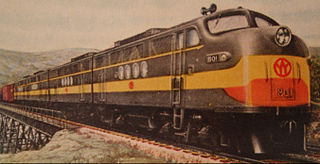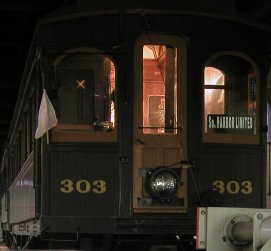
The New York Central Railroad was a railroad primarily operating in the Great Lakes and Mid-Atlantic regions of the United States. The railroad primarily connected greater New York and Boston in the east with Chicago and St. Louis in the Midwest, along with the intermediate cities of Albany, Buffalo, Cleveland, Cincinnati, Detroit, Rochester and Syracuse. New York Central was headquartered in New York City's New York Central Building, adjacent to its largest station, Grand Central Terminal.

The Lake Shore Limited is an overnight passenger train operated by Amtrak between Chicago and the Northeastern United States, with sections to New York City and Boston. The central segment of the route runs along the southern shore of Lake Erie.

Tower City Center is a large mixed-use facility in Downtown Cleveland, Ohio, on its Public Square. The facility is composed of a number of interconnected office buildings, including Terminal Tower, the Skylight Park mixed-use shopping center, Jack Cleveland Casino, Renaissance Cleveland Hotel, Chase Financial Plaza, and Tower City station, the main hub of Cleveland's four RTA Rapid Transit lines.

The Rome, Watertown and Ogdensburg Railroad was a railroad that grew, in stages, from Rome, New York to Watertown and then to Ogdensburg, New York and Massena, New York. The original Rome and Watertown Railroad terminated in Cape Vincent, NY on the St. Lawrence River. A branch of the Rome, Watertown and Ogdensburg Railroad, commonly known as "The Hojack Line", operated along the south shore of Lake Ontario, from Oswego, New York to Niagara Falls, New York.
The Lake Shore and Michigan Southern Railway, established in 1833, and sometimes referred to as the Lake Shore, was a major part of the New York Central Railroad's Water Level Route from Buffalo, New York, to Chicago, Illinois, primarily along the south shore of Lake Erie and across northern Indiana. The line's trackage remains a major rail transportation corridor used by Amtrak passenger trains and several freight lines; in 1998, its ownership was split at Cleveland, Ohio, between CSX Transportation to the east and Norfolk Southern Railway in the west.

The Boston and Albany Railroad was a railroad connecting Boston, Massachusetts to Albany, New York, later becoming part of the New York Central Railroad system, Conrail, and CSX Transportation. The line is currently used by CSX for freight. Passenger service is provided on the line by Amtrak, as part of their Lake Shore Limited service, and by the MBTA Commuter Rail system, which owns the section east of Worcester and operates it as its Framingham/Worcester Line.
The Auburn and Rochester Railroad was a railroad company based in New York state in the 19th century.
The Buffalo and Niagara Falls Railroad was a part of the New York Central Railroad system, connecting Buffalo, New York to Niagara Falls. It is still used by CSX for freight and Amtrak for passenger service.

The New York, Ontario and Western Railway, commonly known as the O&W or NYO&W, was a regional railroad founded in 1868. The last train ran from Norwich, New York to Middletown, New York in 1957, after which it was ordered liquidated by a U.S. bankruptcy judge. It was the first notable U.S. railroad with its mainline entirely abandoned.

Cleveland has been and continues to be deeply rooted in railroad history.

Mercury was the name used by the New York Central Railroad for a family of daytime streamliner passenger trains operating between midwestern cities. The Mercury train sets were designed by the noted industrial designer Henry Dreyfuss, and are considered a prime example of Streamline Moderne design. The success of the Mercury led to Dreyfuss getting the commission for the 1938 redesign of the NYC's flagship, the 20th Century Limited, one of the most famous trains in the United States of America.

Phoebe Snow was a named passenger train which was once operated by the Delaware, Lackawanna and Western Railroad (DL&W) and, after a brief hiatus, the Erie Lackawanna Railway (EL).
The Railroad industry in Syracuse, New York got its start in October 1831 when a convention held in the city marked one of the earliest moves to stimulate the era of railroad building which ultimately brought steam railroad service to New York State.
The Syracuse and Binghamton Railroad was established on August 18, 1851, and opened for business on October 18, 1854. The road merged in 1856 into Syracuse and Southern Railroad which was renamed to Syracuse, Binghamton and New York Railroad when the company reorganized after foreclosure in 1857.
The Rochester and Syracuse Railroad was a double-track, high-speed line 87 miles (140 km) long that ran between Rochester and Syracuse, New York. The tracks paralleled the New York Central Railroad and the Erie Canal and had only one grade crossing with another railroad its entire length.
The Auburn Trail is a multi-use rail trail located principally in the towns of Victor and Farmington, Ontario County, New York (USA). It is approximately 11 miles (18 km) long and maintained by the Towns of Victor and Farmington and Victor Hiking Trails. The trail mostly follows the alignment of the Auburn and Rochester Railroad. Additional disconnected portions of the Auburn trail are found in the Towns of Pittsford and Brighton, Monroe County, NY. A detailed description and map of the Auburn Trail are available from Victor Hiking Trails.

The Ohio State Limited was a named passenger train operated by the New York Central Railroad (NYC) between New York City and Cincinnati, Ohio, via Buffalo and Cleveland, Ohio. Service began in 1924 and continued until 1967, with some vestiges remaining until 1971.
The Rochester, Lockport and Buffalo Railroad was an electric interurban railway that was constructed between Rochester, New York, and Lockport, New York, connecting to the International Railway Co. at Lockport for service into Buffalo. Opened in 1909 as the Buffalo, Lockport and Rochester Railway, the route followed the Erie Canal and the New York Central Railroad's Falls Road branch for most of its length. For a brief period of time, the railway was part of the Beebe Syndicate of affiliated interurban railways stretching from Syracuse to Buffalo. Entering receivership in 1917, it was reorganized as the Rochester, Lockport and Buffalo Railroad in 1919. After years of struggling with declining revenue during the Depression years, the railway's last day of service was April 30, 1931.
The Southwestern Limited was a passenger train service operated by the New York Central Railroad between New York City and St. Louis, from 1889 to 1966. The Southwestern Limited was one of the New York Central's luxury passenger trains. This passenger train competed with the other major railroad in the northeast, the Pennsylvania Railroad, and its Blue Ribbon named passenger trains the St. Louisan, the Jeffersonian, the Penn Texas and the Spirit of St. Louis.

Syracuse station was the Delaware, Lackawanna and Western's railroad station in Syracuse, New York. It was housed in different buildings in succession. It hosted trains going north to Oswego, New York on the Lake Ontario coast by way of the DLW's acquisition, the former Oswego and Syracuse Railroad; and it also hosted trains going south to Binghamton on the route of the former Syracuse and Binghamton Railroad, and further to Hoboken, New Jersey.











